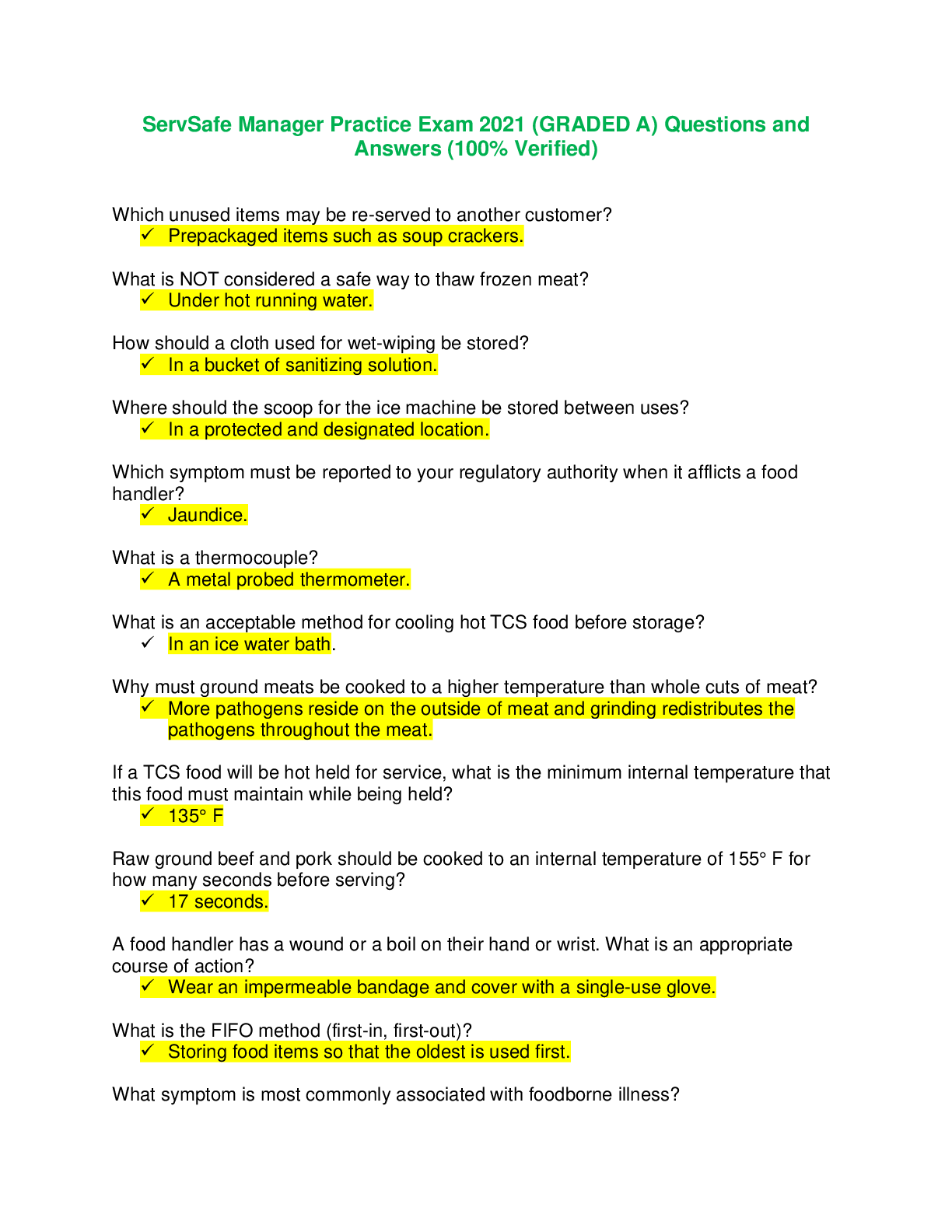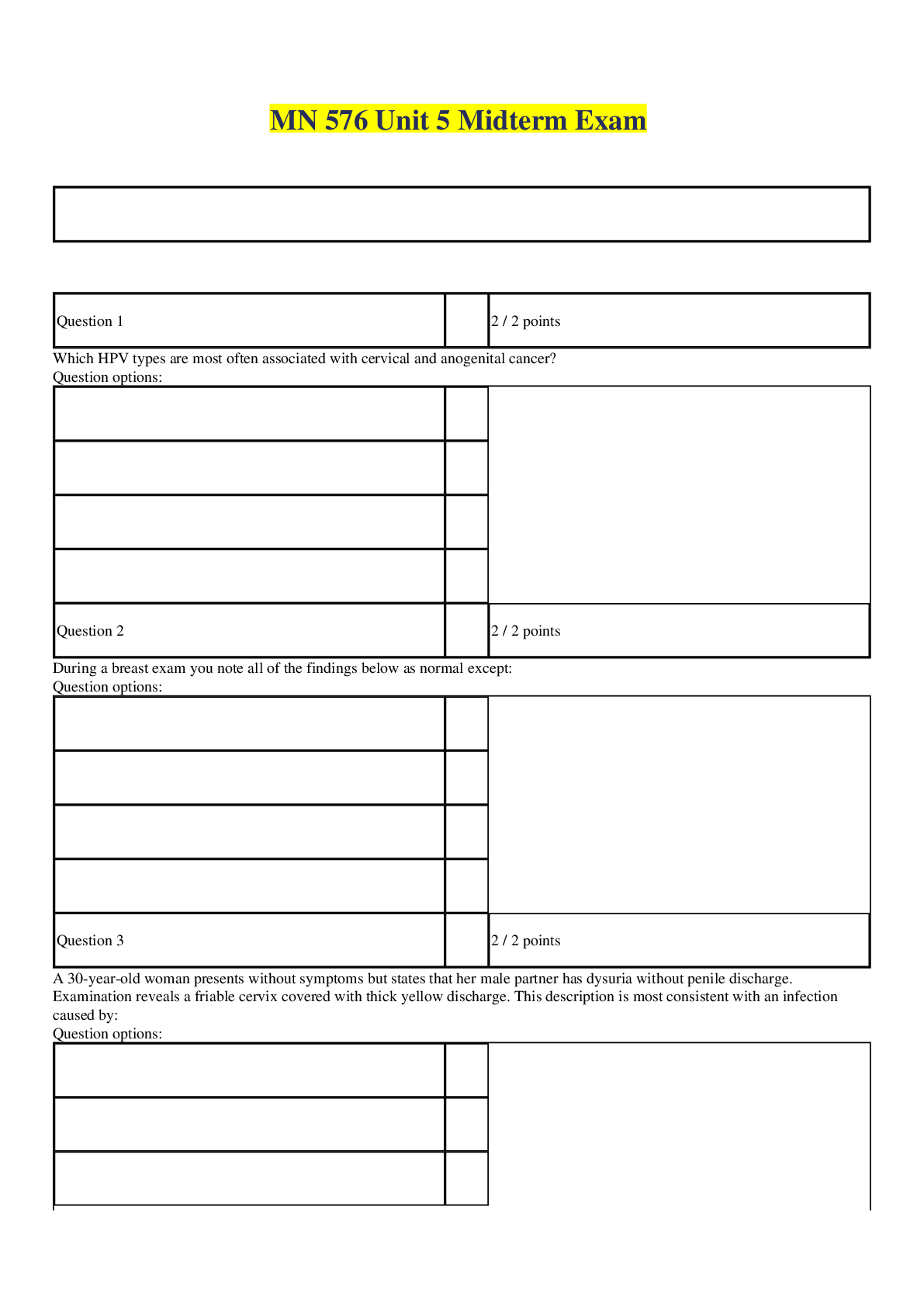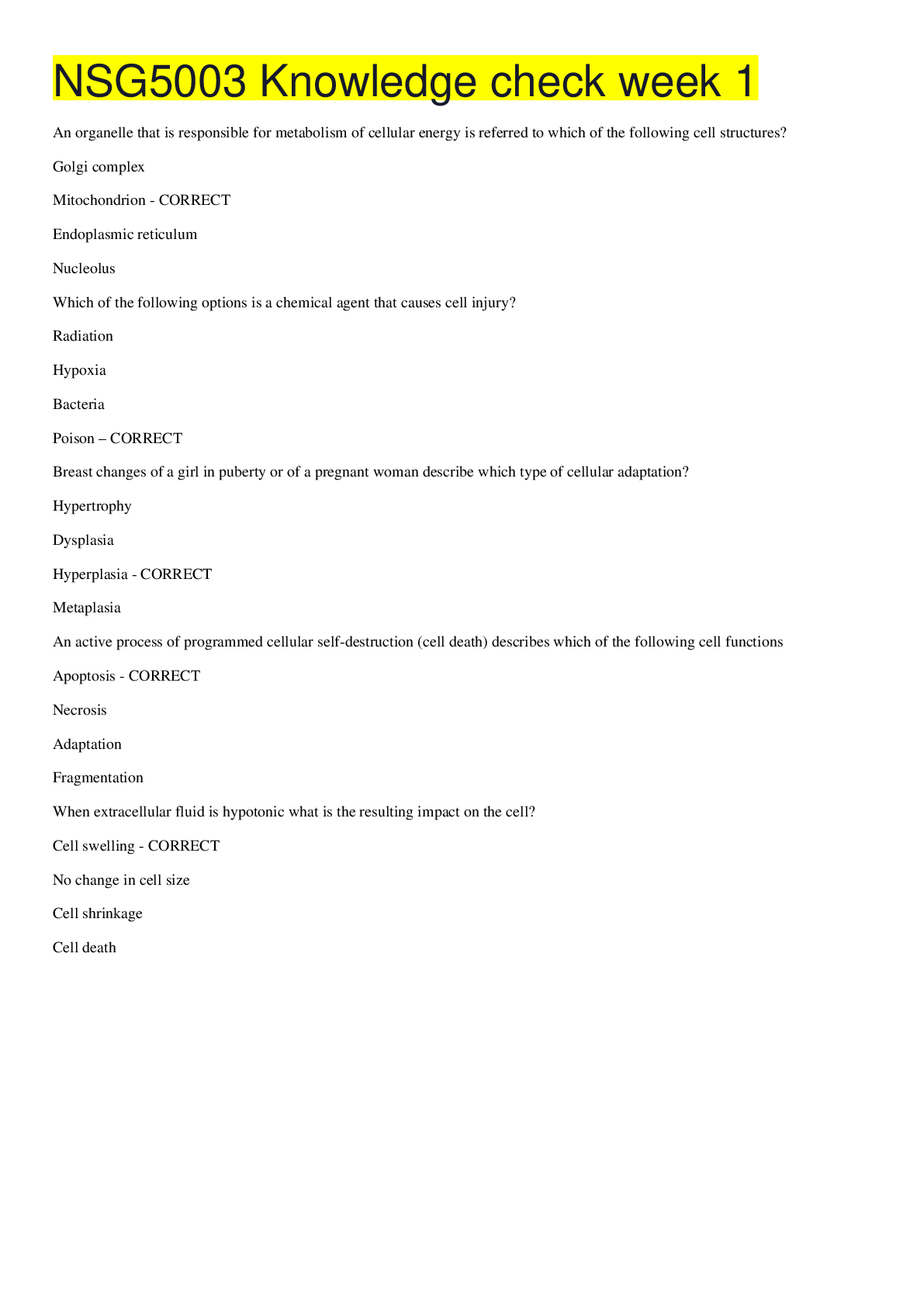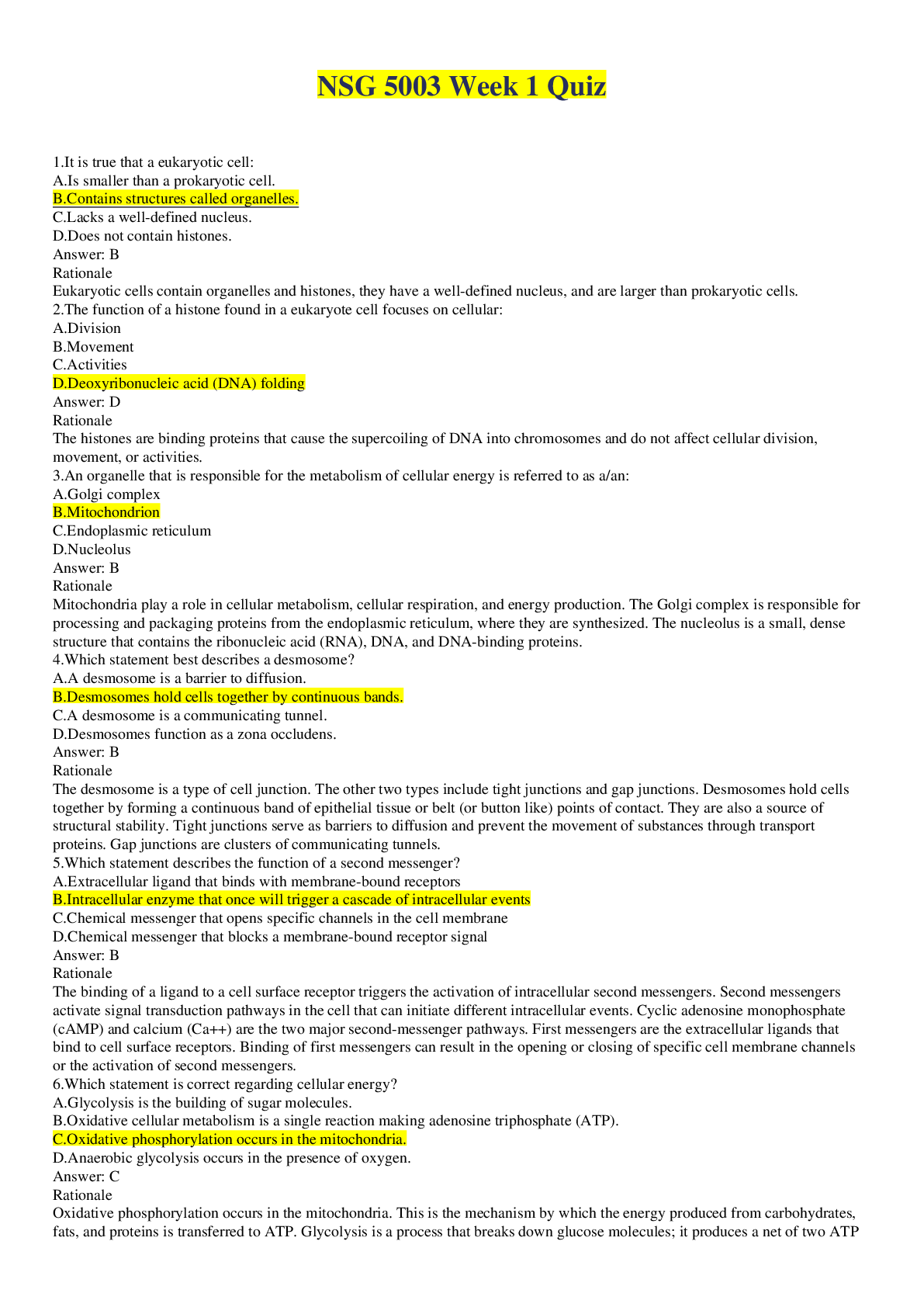Micro Biology > EXAM > Week 1 Microbiology Quiz (100% CORRECT SOLUTIONS) | Download To Score An A (All)
Week 1 Microbiology Quiz (100% CORRECT SOLUTIONS) | Download To Score An A
Document Content and Description Below
Week 1 Microbiology Quiz 1. Question : (TCO 1) Why are microorganisms so important to our ecosystems? Student Answer: They enrich soil. They degrade wastes. They support life. None of t... he above All of the above Instructor Explanation: Chapter 1, Introduction page Question 2. Question : (TCO 1) The scientific method consists of four basic steps. Which option below shows the correct sequence of events? Student Answer: Observe results, Generate hypothesis, Ask a question based upon observations, Conduct experiment Conduct experiment, Ask a question based upon observations, Generate hypothesis, Observe results Generate hypothesis, Conduct experiment, Observe results, Ask a question based upon observations Ask a question based upon observations, Generate hypothesis, Conduct experiment, Observe results None of the above orders are correct. Instructor Explanation: Chapter 1, The Golden Age of Microbiology section Question 3. Question : (TCO 1) Which of the following is a practical application of the use of Saccharomyces cerevisiae? Student Answer: To distill water To make yogurt To make beer To make flat bread To treat yeast infections Instructor Explanation: Chapter 1, The Early Years of Microbiology section Question 4. Question : (TCO 1) Which of the following statement(s) is true of yeasts? Student Answer: They have cell walls. They reproduce by budding. They are used to make breads. They are used to make wine and brew beer. All of the above Instructor Explanation: Chapter 1, The Early Years of Microbiology section Question 5. Question : (TCO 2) Which of the following is NOT an example of an archaea? Student Answer: An organism isolated from the Dead Sea An organism producing methane in ocean sediments An organism found in deep-sea hydrothermal vents An organism isolated from hot springs An organism causing pneumonia in an elderly person Instructor Explanation: Chapter 11, Survey of Archaea section Question 6. Question : (TCO 2) Which of the following statements about prokaryotic arrangement is TRUE? Student Answer: The palisade arrangement is common in the Streptococci species. Diplococci look like pairs of bacteria under the microscope. Staphyloccus species commonly form long chains of cocci. Prokaryotes that divide by binary fission are always found as single cells. A grapelike cluster of cells is known as a sarcina. Instructor Explanation: Chapter 11, General Characteristics of Prokaryotes section Question 7. Question : (TCO 2) What is the potential overall magnification of a microscope that has a 10X ocular lens and a 40X objective lens? Student Answer: 10X 40X 390X 400X 410X Instructor Explanation: Chapter 4, Microscopy section Question 8. Question : (TCO 2) Which unit of measurement is used to measure intracellular organelles and viruses? Student Answer: Centimeter Decimeter Micrometer Nanometer Picometer Instructor Chapter 4, Units of Measurement section Explanation: 9. Question : (TCO 2) How is the information in a dichotomous key arranged? Student Answer: It is usually arranged so the species will move from a bottom-to- top approach to determine if a cell is Gram positive or Gram negative. It is arranged as a stepwise choice between paired characteristics. It allows three possible outcomes as the organisms are moved down from one level to the next. It is arranged as a pyramid. It is arranged in concentric circles. Instructor Explanation: Chapter 4, Classification and Identification of Microorganisms section Question 10. Question : (TCO 2) Bacterial cells with bound antibodies carrying dye are best observed with which type of microscope? Student Answer: Atomic force microscope Confocal microscope Transmission electron microscope Scanning electron microscope Bright field microscope Instructor Explanation: Chapter 4, Microscopy section 1. Question : (TCO 2) A microbiologist wants to study the process of viral infection of animal cells. She wants to be able to see the viruses as they enter the cells. (a) What microscope would you suggest she use for these studies? Why? (5 pts.) (b) How should she prepare her samples for microscopy? (5 pts.) Student Answer: I would suggest using an electron microscope to view virus entry into the cell. I would choose this electron microscope because it has a higher resolving power than light microscope because of the use of electrons instead of light. Electron microscope allows the scientist to view structure within a cell. They form an image of the specimen at magnification of 500,000 times. She can also use cryo-electron microscopy , electron tomography. --- which shows how virus attaches itself to the cells and assimilate during replication. The microbiologist can prepare the slide by using negative staining --- rapid procedure used for viewing small particles such as virus in fluids. Instructor Explanation: Chapter 4, Microscopy section (a) The microbiologist needs to use an electron or atomic force microscope to be able to see the tiny viruses. Scanning electron microscopes (SEM) can produce three-dimensional images of the physical contact between virus and cell, providing information on what portions of the virus are in contact with what structures of the cell. A transmission electron microscope (TEM) may provide information about structures and interactions obscured by the intact virus. Scanning tunneling or atomic force microscopy of separate preparations of viruses and cells can provide details about the structures on each that interact when the virus is in contact with the surface of the cell. (b) A mixture of cells and viruses is dried onto the surface of the sample holder and coated with metal to prepare it for the SEM. Before TEM, samples are dried, embedded in plastic, sliced into thin (100 nm) sections, and stained with heavy metals (osmium, tungsten, etc.) to increase contrast. The preparation of specimens for atomic force microscopy is minimal, because the material does not need to be dried, sectioned, or stained. [Show More]
Last updated: 2 years ago
Preview 1 out of 19 pages
.png)
Buy this document to get the full access instantly
Instant Download Access after purchase
Buy NowInstant download
We Accept:

Reviews( 0 )
$11.00
Can't find what you want? Try our AI powered Search
Document information
Connected school, study & course
About the document
Uploaded On
Jan 17, 2022
Number of pages
19
Written in
Additional information
This document has been written for:
Uploaded
Jan 17, 2022
Downloads
0
Views
47

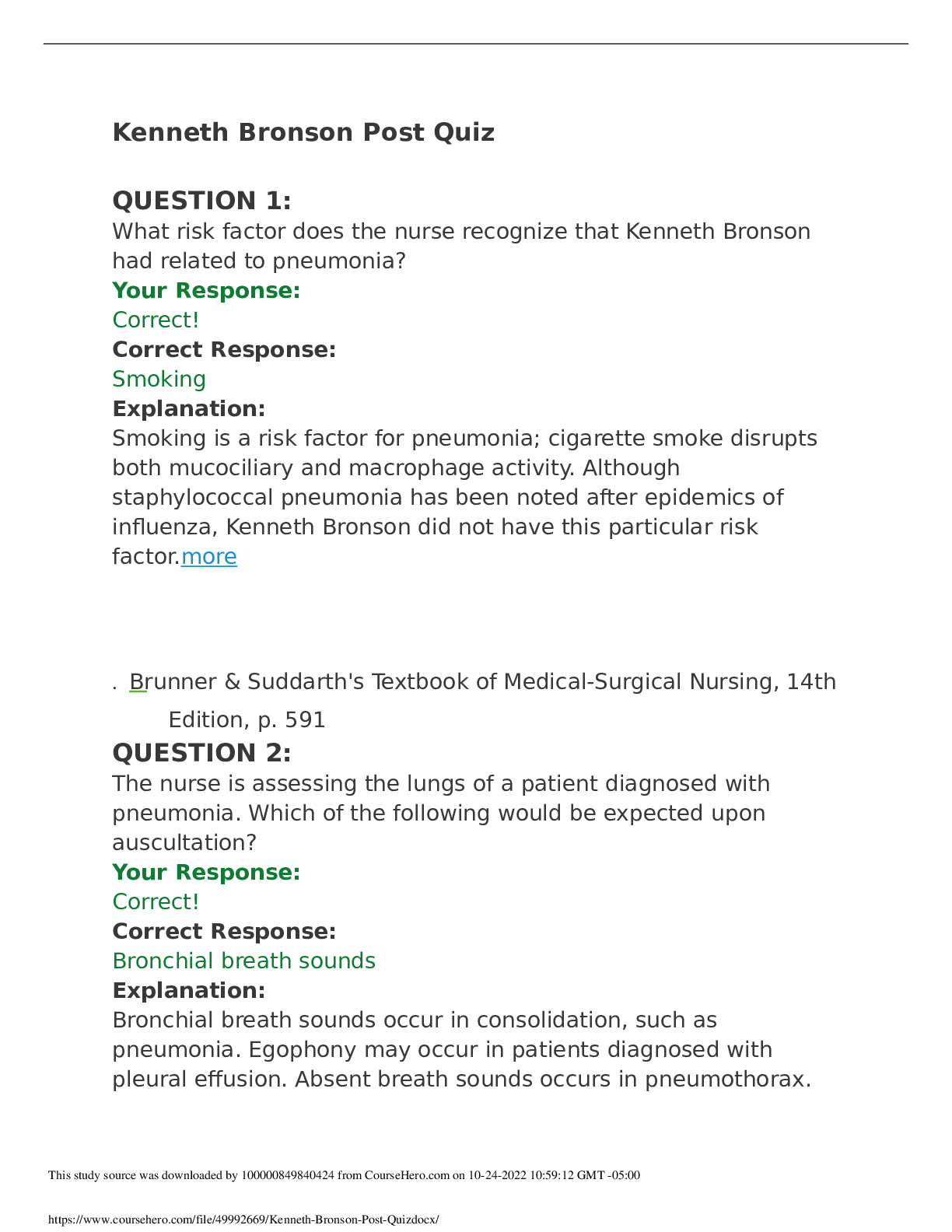



 Questions and Answers 100% VERIFIED.png)
 Questions and Answers 100% correct Solutions.png)



